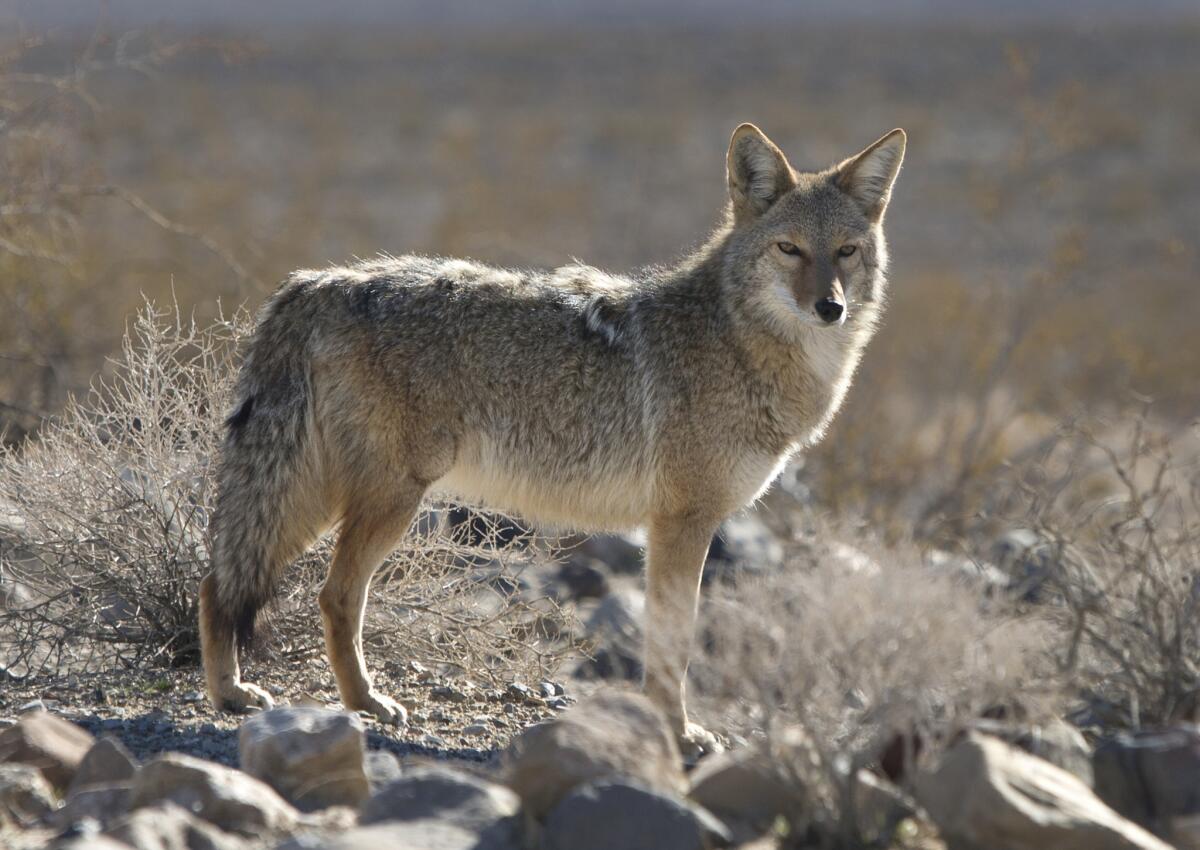Irvine neighborhood uses education to remove welcome mat for coyotes

Portola Springs residents have been told to keep coyotes away by eliminating trash, pet food and water. Above, a coyote in Death Valley.
In response to an increase in coyote sightings and attacks on pets and children, a newly developed Irvine neighborhood has launched a program to help residents coexist with the animals that come down from nearby hills in search of food.
Known as Wildlife Watch, the program encourages residents to eliminate things that attract coyotes, such as trash, pet food and water; report sightings; and attempt to haze, or scare away, the animals.
Irvine police, California Department of Fish and Wildlife officials and about 50 Portola Springs residents attended a community meeting this week to learn more about the education initiative, which is similar to the crime-prevention program Neighborhood Watch.
The wildlife training program has been tested in Fountain Valley, Yorba Linda, Huntington Beach and Seal Beach during the past six years with some success, Lt. Kent Smirl of the Department of Fish and Wildlife said.
Coyote sightings and attacks are common in Orange County. In Newport Beach and Irvine, some residents have started arming themselves with bats, sticks and pepper spray when walking their dogs. Others refuse to go out past dark for fear that a coyote might snatch their pets.
“These coyotes are pretty comfortable here,” Smirl said. “If we don’t change our behavior, they’re going to keep coming back.”
Portola Springs resident Hamed Zareei said he encountered a coyote during his first walk around the neighborhood with his fiancée’s dogs after moving to the area in June.
Zareei was walking the Pomeranian and the Chihuahua in the early evening when a coyote appeared, snarling, on the sidewalk next to them. Zareei pulled the Pomeranian up by its collar, but before he could grab the Chihuahua, the coyote snatched it and ran.
Zareei said he handed the Pomeranian to a neighbor who was driving by and then he took off after the coyote. When he caught up, he kicked it hard enough to knock the Chihuahua out of its mouth.
“I wasn’t about to have to tell my fiancée that her dog was eaten by a coyote,” he said. “Not on my watch.”
The dog, named Yogi, suffered puncture wounds on his neck and body, but survived.
Portola Springs is one of Irvine’s newer housing developments. In addition to attacking pets, coyotes have bitten or scratched four children in the community fromMay 22 to July 5, according to Fish and Wildlife officials.
Though there are typically about 450 coyote sightings per year in Irvine, the number of attacks on humans there has been low, authorities said. Three attacks were reported from 2000 to 2013. But the proximity of the Portola Springs homes to the undeveloped canyons probably accounts for some of the coyote activity, Smirl said.
And the coyotes’ seeming fearlessness toward humans indicates that people have been feeding them — either unintentionally or in an attempt to keep them from snatching their pets, he said.
“People tend to forget that wild animals are in fact wild,” Smirl said. “We pay the consequences because [the animals] continue to return.”
Follow@hannahfrytcn
More to Read
Get the Latinx Files newsletter
Stories that capture the multitudes within the American Latinx community.
You may occasionally receive promotional content from the Los Angeles Times.







